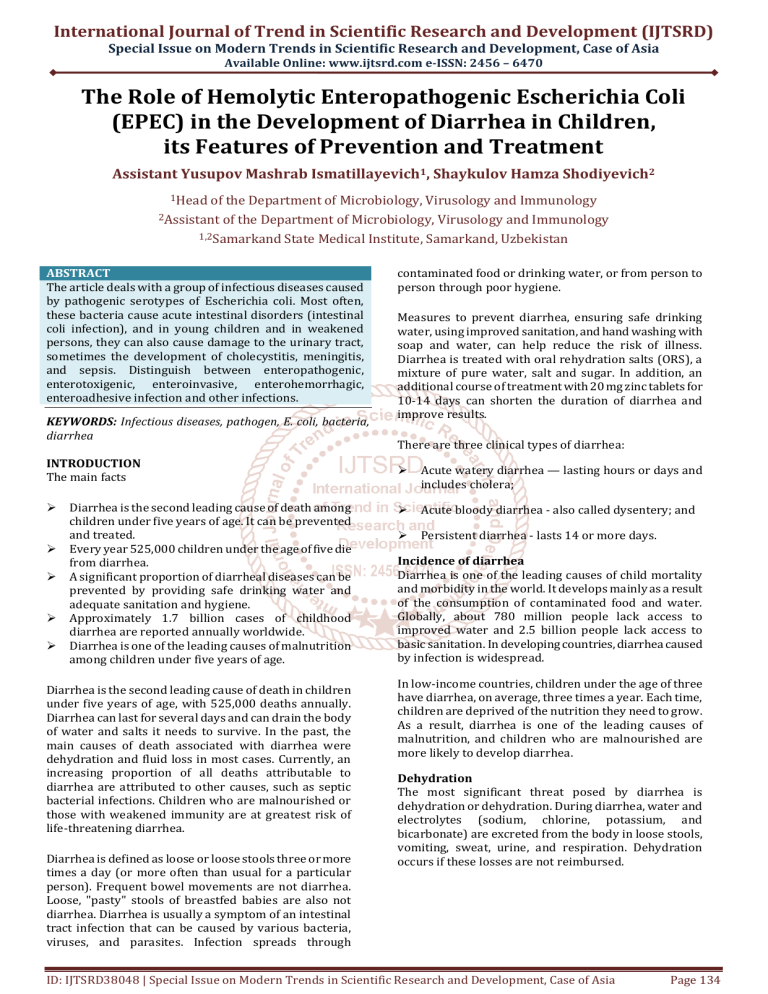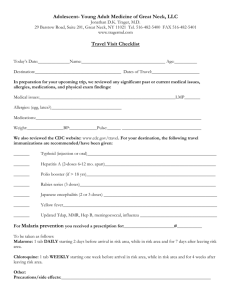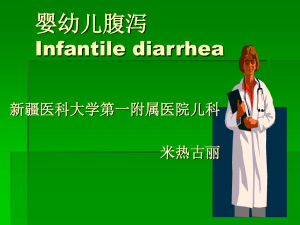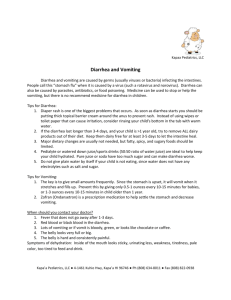
International Journal of Trend in Scientific Research and Development (IJTSRD)
Special Issue on Modern Trends in Scientific Research and Development, Case of Asia
Available Online: www.ijtsrd.com e-ISSN: 2456 – 6470
The Role of Hemolytic Enteropathogenic Escherichia Coli
(EPEC) in the Development of Diarrhea in Children,
its Features of Prevention and Treatment
Assistant Yusupov Mashrab Ismatillayevich1, Shaykulov Hamza Shodiyevich2
1Head of
the Department of Microbiology, Virusology and Immunology
the Department of Microbiology, Virusology and Immunology
1,2Samarkand State Medical Institute, Samarkand, Uzbekistan
2Assistant of
ABSTRACT
The article deals with a group of infectious diseases caused
by pathogenic serotypes of Escherichia coli. Most often,
these bacteria cause acute intestinal disorders (intestinal
coli infection), and in young children and in weakened
persons, they can also cause damage to the urinary tract,
sometimes the development of cholecystitis, meningitis,
and sepsis. Distinguish between enteropathogenic,
enterotoxigenic, enteroinvasive, enterohemorrhagic,
enteroadhesive infection and other infections.
KEYWORDS: Infectious diseases, pathogen, E. coli, bacteria,
diarrhea
INTRODUCTION
The main facts
➢
➢
➢
➢
➢
Diarrhea is the second leading cause of death among
children under five years of age. It can be prevented
and treated.
Every year 525,000 children under the age of five die
from diarrhea.
A significant proportion of diarrheal diseases can be
prevented by providing safe drinking water and
adequate sanitation and hygiene.
Approximately 1.7 billion cases of childhood
diarrhea are reported annually worldwide.
Diarrhea is one of the leading causes of malnutrition
among children under five years of age.
Diarrhea is the second leading cause of death in children
under five years of age, with 525,000 deaths annually.
Diarrhea can last for several days and can drain the body
of water and salts it needs to survive. In the past, the
main causes of death associated with diarrhea were
dehydration and fluid loss in most cases. Currently, an
increasing proportion of all deaths attributable to
diarrhea are attributed to other causes, such as septic
bacterial infections. Children who are malnourished or
those with weakened immunity are at greatest risk of
life-threatening diarrhea.
Diarrhea is defined as loose or loose stools three or more
times a day (or more often than usual for a particular
person). Frequent bowel movements are not diarrhea.
Loose, "pasty" stools of breastfed babies are also not
diarrhea. Diarrhea is usually a symptom of an intestinal
tract infection that can be caused by various bacteria,
viruses, and parasites. Infection spreads through
contaminated food or drinking water, or from person to
person through poor hygiene.
Measures to prevent diarrhea, ensuring safe drinking
water, using improved sanitation, and hand washing with
soap and water, can help reduce the risk of illness.
Diarrhea is treated with oral rehydration salts (ORS), a
mixture of pure water, salt and sugar. In addition, an
additional course of treatment with 20 mg zinc tablets for
10-14 days can shorten the duration of diarrhea and
improve results.
There are three clinical types of diarrhea:
➢
Acute watery diarrhea — lasting hours or days and
includes cholera;
➢
Acute bloody diarrhea - also called dysentery; and
➢
Persistent diarrhea - lasts 14 or more days.
Incidence of diarrhea
Diarrhea is one of the leading causes of child mortality
and morbidity in the world. It develops mainly as a result
of the consumption of contaminated food and water.
Globally, about 780 million people lack access to
improved water and 2.5 billion people lack access to
basic sanitation. In developing countries, diarrhea caused
by infection is widespread.
In low-income countries, children under the age of three
have diarrhea, on average, three times a year. Each time,
children are deprived of the nutrition they need to grow.
As a result, diarrhea is one of the leading causes of
malnutrition, and children who are malnourished are
more likely to develop diarrhea.
Dehydration
The most significant threat posed by diarrhea is
dehydration or dehydration. During diarrhea, water and
electrolytes (sodium, chlorine, potassium, and
bicarbonate) are excreted from the body in loose stools,
vomiting, sweat, urine, and respiration. Dehydration
occurs if these losses are not reimbursed.
ID: IJTSRD38048 | Special Issue on Modern Trends in Scientific Research and Development, Case of Asia
Page 134
International Journal of Trend in Scientific Research and Development (IJTSRD) @ www.ijtsrd.com eISSN: 2456-6470
There are three degrees of dehydration.
➢
Severe dehydration (at least two of the following):
➢
➢
➢
➢
➢
➢
lethargy / unconsciousness;
sunken eyes;
the patient cannot drink or drinks badly;
after pinching, the skin returns to its original
state very slowly (≥2 seconds).
Moderate dehydration:
✓ restless behavior, irritability;
✓ sunken eyes;
✓ the patient drinks with greed, is thirsty.
No dehydration (not enough evidence to qualify as
moderate or severe dehydration).
The reasons
➢
➢
health education about the ways of spreading
infections;
vaccination against rotavirus infection.
The main measures for treating diarrhea include the
following:
➢
➢
➢
➢
Rehydration: with oral rehydration salt (ORS)
solution. ORS is a mixture of pure water, salt and
sugar that can be safely prepared at home.
Treatment with this mixture costs a few cents. ORS is
absorbed in the small intestine and replaces water
and electrolytes excreted in feces.
Zinc supplements: Zinc supplements reduce the
duration of diarrhea by 25% and lead to a decrease
in stool volume by 30%.
Rehydration via IV line in case of acute dehydration
or shock.
Nutrient-rich foods: The cycle of malnutrition and
diarrhea can be broken by feeding children nutrientrich foods (including breast milk) during diarrhea
and then feeding recovered children nutritious foods
(including exclusive breastfeeding during the first six
months of life).
Consult with a healthcare professional, in particular
regarding the management of persistent diarrhea, blood
in stools or signs of dehydration.
Infection: Diarrhea is a symptom of infections caused by
a wide variety of bacteria, viruses and parasites, most of
which are spread through fecal contaminated water.
Infections are most common where there is a shortage of
clean water for drinking, cooking and personal hygiene.
Rotavirus and Escherichia coli are the two most common
causes of diarrhea, both moderate and severe, in lowincome countries. Other pathogens, such as
cryptosporidium and shigella, may also be relevant. It is
also necessary to take into account the etiological
patterns characteristic of a particular area.
➢
Malnutrition: Children dying of diarrhea often suffer
from concomitant malnutrition, which makes them more
vulnerable. Each case of diarrhea, in turn, exacerbates
their malnutrition. Diarrhea is one of the leading causes
of malnutrition among children under five years of age.
[2]
Диарея путешественников | Медицинская газета
«Здоровье Украины», Медицинское издание,
медицинские издательства в Украине
[3]
http://www.infectology.ru/nosology/infectious/bact
eriosis/escherichiosis.aspx Эшерихиоз
[4]
Gene Sequence Of Deadly E. Coli Reveals Surprisingly
Dynamic Genome (недоступная ссылка). Science
Daily (25 января 2001). Дата обращения 8 февраля
2007. Архивировано 21 февраля 2007 года.
[5]
http://medkarta.com/?cat=article&id=19158 Лечени
е
[6]
Therapeutic use of bacteriophages in bacterial
infections (недоступная ссылка). Polish Academy of
Sciences. Дата
обращения
10
января
2013. Архивировано 8 февраля 2006 года.
[7]
Medical
conditions
treated
with
phage
therapy (недоступная ссылка). Phage Therapy
Center. Дата
обращения
10
января
2013. Архивировано 23 октября 2012 года.
[8]
Girard M., Steele D., Chaignat C., Kieny M. A review of
vaccine research and development: human enteric
infections (англ.) // Vaccine : journal. — 2006. — Vol.
24, no.
15. — P.
2732
2750.
—
doi:10.1016/j.vaccine.2005.10.014. — PMID
16483695.
Source: Of particular concern is water contaminated
with human faeces, such as from wastewater,
sedimentation tanks and latrines. Animal faeces also
contain microorganisms that can cause diarrhea.
Other causes: Diarrhea can also spread from person to
person, exacerbated by inadequate personal hygiene.
Food is another significant cause of diarrhea when
prepared or stored in unhygienic conditions. The unsafe
storage and handling of water in the household is also an
important factor. Fish and seafood from contaminated
water can also cause this disease.
Prevention and treatment
Basic measures to prevent diarrhea include the following:
➢
➢
➢
➢
➢
access to safe drinking water;
improved sanitation facilities;
washing hands with soap;
exclusive breastfeeding of the baby during the first
six months of life;
proper personal and food hygiene;
References
[1] Коли-инфекция кишечная Большая российская
энциклопедия
электронная
версия.
bigenc.ru. Дата обращения 27 августа 2019.
ID: IJTSRD38048 | Special Issue on Modern Trends in Scientific Research and Development, Case of Asia
Page 135





